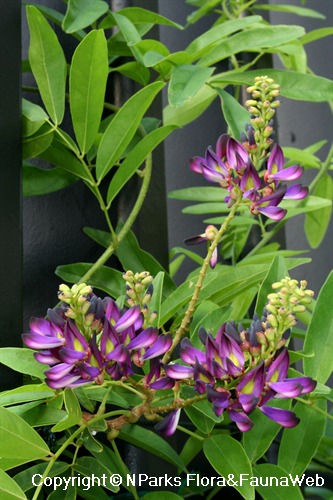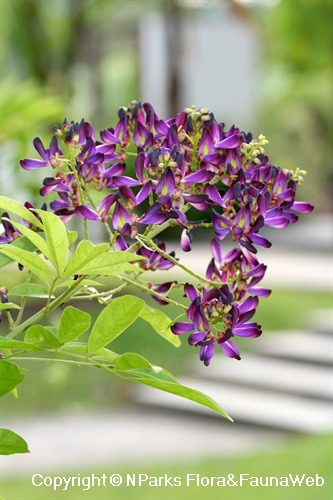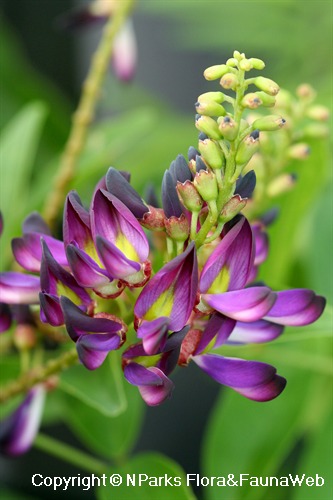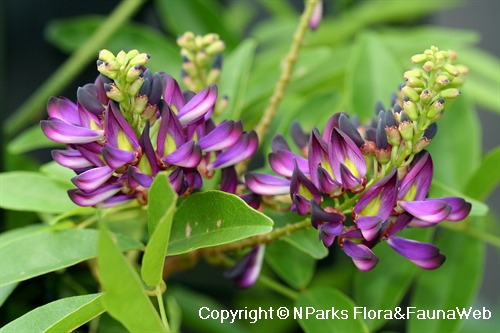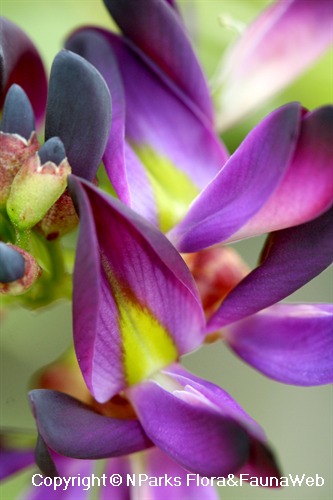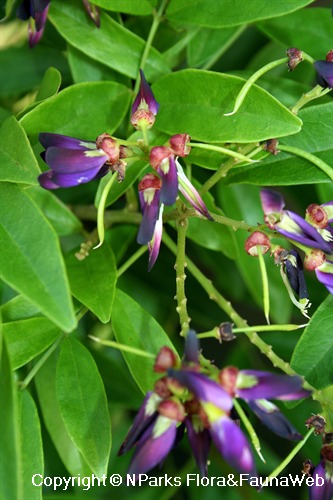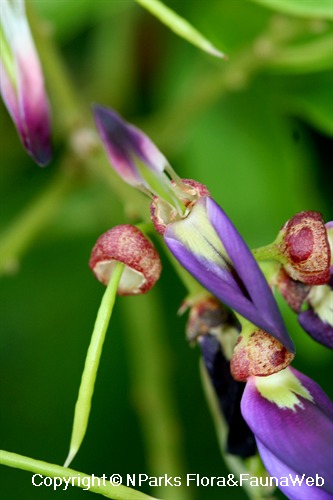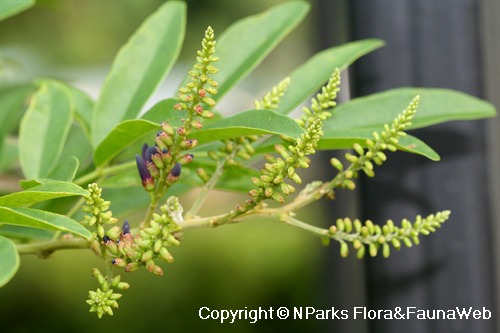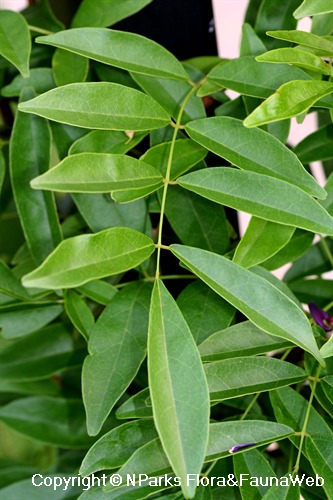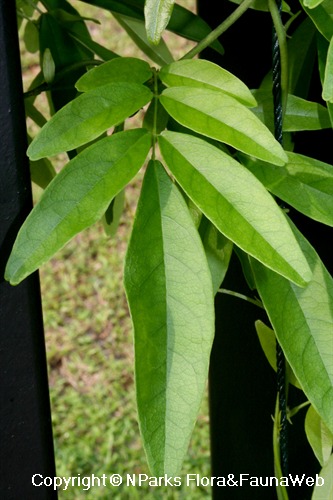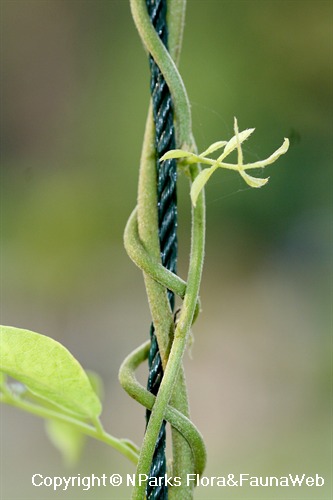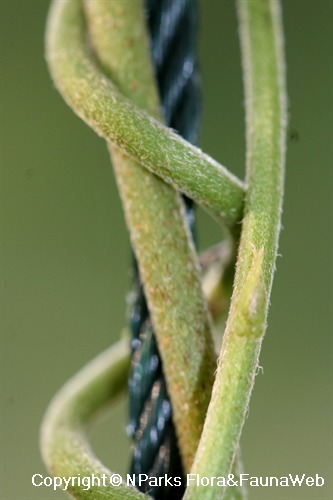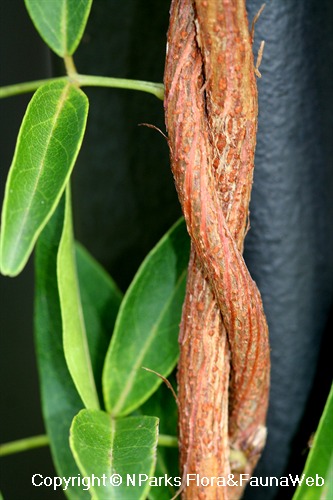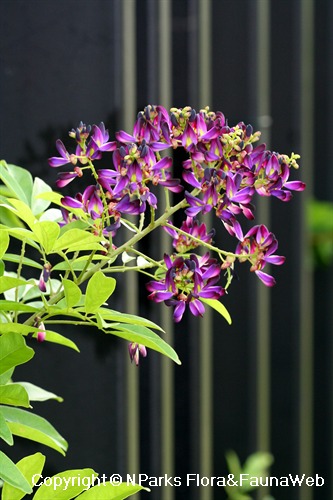.jpg)
Back
Callerya reticulata (Benth.) Schot.
| Family Name: | Fabaceae (Leguminosae) |
| Synonyms: | Millettia championii, Millettia kiangsiensis, Millettia reticulata |
| Common Name: | Evergreen Wisteria, Leatherleaf Millettia, 鸡血藤, 老荊藤 |
Name
Classifications and Characteristics
| Plant Division | Angiosperms (Flowering Seed Plants) (Dicotyledon) |
|---|---|
| Plant Growth Form | Climber, Shrub |
| Lifespan (in Singapore) | Perennial |
| Mode of Nutrition | Autotrophic |
| Plant Shape | Shrubby |
| Maximum Height | 3.5 m to 4.5 m |
| Maximum Plant Spread / Crown Width | 0.9 m to 1.8 m |
Biogeography
| Native Distribution | China, Hong Kong, Taiwan, Vietnam |
|---|---|
| Preferred Climate Zone | Sub-Tropical / Monsoonal, Temperate |
| Local Conservation Status | Non-native (Horticultural / Cultivated Only) |
Description and Ethnobotany
| Growth Form | A liana, woody twining vine, climbing up to around 10 m height, with 1.8 m spread. |
|---|---|
| Foliage | Leaves compound, each composed of 7-13 leathery leaflets; blades ovate-elliptical, oblong, sometimes narrowly lanceolate, base rounded or cuneate, apex acuminate or retuse; each leaftlet measures at about 3 x 1 cm to 6 x 4 cm; texture smooth papery. |
| Stems | Stem thick, many branched; young woody stems have rather attractive, reddish brown bark, pubescent then glabrescent at maturity. |
| Flowers | Flowers pea-like, bluish-purple petals with bright yellow in the centre, weakly scented like camphor or cedar, with reproductive parts enclosed within the lower petal and visited by ants; large panicles or racemes, 15-20cm across, usually hidden amongst the dense foliage, pendulous, panicles axillary or terminal near the branchlets apex. |
| Fruit | Fruits are velvety, elongated explosive pods, blacken when dry; contain black oblong seeds. |
| Similar | Very similar-looking to Callerya taiwanensis (syn. Millettia taiwanensis), which has a more shrubby habit and is less heat-tolerant. |
| Taxonomy | Despite its common name, plant is not related to the Chinese Wisteria (Wisteria sinensis), a larger and more aggressive climber found in temperate climates. |
| Cultivation | Ideal as a neat, fine-textured cover for trellises, arbors and fences, where ornamental flowers provide an added surprise of mothball-like scent when closely sniffed. Also occasionally cutlivated as bonsai. Prefers fertile, loose, well-drained soils. Avoid using nitrogen-rich fertilizers to promote better flowering. Remove spent flowers to encourage faster re-blooming. |
| Etymology | Genus epithet 'Callerya' named in honour of 19th century French missionary Joseph Callery, who travelled and collected botanical specimens in China. Species epithet 'reticulata' means 'netted', a reference to the plant's pinnate leaf venation. |
| Ethnobotanical Uses | Food (Herb or Spice) Others: Commonly known as 鸡血藤 (Ji Xue Teng, literally 'Chicken Blood Stem') in Chinese folk medicine, due to the reddish resin contained within the woody stems. Traditionally used in herbal decoctions to treat blood, menstrual and circulation-related disorders. Also has anti-inflammatory properties, and used to relieve autoimmune diseases like rheumatoid arthritis. |
Landscaping Features
| Desirable Plant Features | Ornamental Flowers, Fragrant (Flowers) (Day, Time Independent) |
|---|---|
| Landscape Uses | Suitable for Bonsai, Vertical Greenery / Green Wall, Container Planting, Trellis / Arbour / Pergola |
| Thematic Landscaping | Fragrant / Aromatherapy Garden, Naturalistic Garden |
| Plant & Rootzone Preference or Tolerance Remarks | Soil pH 5.6 - 7.5 |
Fauna, Pollination and Dispersal
| Pollination Method(s) | Biotic (Fauna) (Insects (Ant, Beetle, Fly, Thrip, Wasp)) |
|---|---|
| Seed or Spore Dispersal | Abiotic (Explosive Dehiscence) |
Plant Care and Propagation
| Light Preference | Full Sun |
|---|---|
| Water Preference | Moderate Water |
| Plant Growth Rate | Moderate |
| Rootzone Tolerance | Fertile Loamy Soils, Well-Drained Soils |
| Maintenance Requirements | Moderate |
| Fertilizing | Fertilize with water-soluble fertilizer every 2 weeks. |
| Propagation Method | Seed, Stem Cutting |
| Propagule Establishment Remarks | Pre-soak seed for 12 hours in warm water before sowing. Remove leaves from softwood cuttings. |
| Propagation Method Remarks | Allow seedpods to dry on plant before collecting. Use seeds as soon as possible. For cuttings, use softwood cuttings |
| Planting Distance | 1 to 1 |
Foliar
| Foliage Retention | Evergreen |
|---|---|
| Mature Foliage Colour(s) | Green |
| Mature Foliage Texture(s) | Smooth, Papery |
| Foliar Type | Compound (Odd-Pinnate) |
| Foliar Arrangement Along Stem | Opposite |
| Foliar Shape(s) | Non-Palm Foliage (Elliptical, Lanceolate, Oblong) |
| Foliar Venation | Pinnate / Net |
| Foliar Margin | Entire |
| Foliar Apex - Tip | Acuminate, Retuse |
| Foliar Base | Cuneate, Rounded / Obtuse |
| Typical Foliar Area | Microphyll ( 2.25cm2 - 20.25 cm2 ) |
Non - Foliar and Storage
| Bark Colour(s) | Reddish brown |
|---|---|
| Mature Bark Texture | Lenticellate |
| Stem Type & Modification | Woody, Herbaceous |
| Root Type | Underground (Fibrous Root) |
Floral (Angiosperm)
| Flower & Plant Sexuality | Bisexual Flowers |
| Flower Colour(s) | Blue, Purple, Yellow / Golden |
|---|---|
| Flower Grouping | Cluster / Inflorescence |
| Flower Location | Axillary, Terminal |
| Flower Symmetry | Bilateral |
| Individual Flower Shape | Papilionaceous / Pea-shaped |
| Flower Size - Remarks | 1.3 cm long flowers in 15-20cm long clusters |
| Inflorescence Type | Panicle, Raceme |
| Flower Lifespan on Plant | Several Days |
| Flowering Habit | Polycarpic |
| Flower Texture(s) Remarks | Glabrescent |
Fruit, Seed and Spore
| Mature Fruit Colour(s) | Black |
|---|---|
| Mature Fruit Texture(s) | Leathery |
| Fruit Classification | Simple Fruit |
| Fruit Type | |
| Mature Seed Colour(s) | Black |
| Seed Quantity Per Fruit | Few (1-5), Moderate (6-10) |
Image Repository
Others
| Master ID | 14248 |
|---|---|
| Species ID | 3329 |
| Flora Disclaimer | The information in this website has been compiled from reliable sources, such as reference works on medicinal plants. It is not a substitute for medical advice or treatment and NParks does not purport to provide any medical advice. Readers should always consult his/her physician before using or consuming a plant for medicinal purposes. |

.jpg)
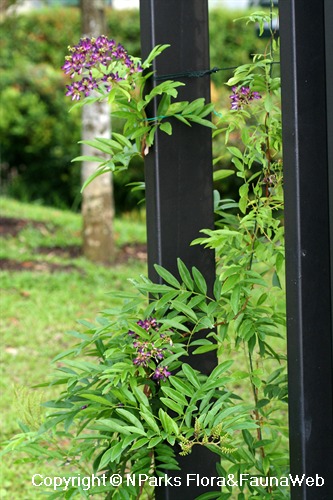
.jpg)
